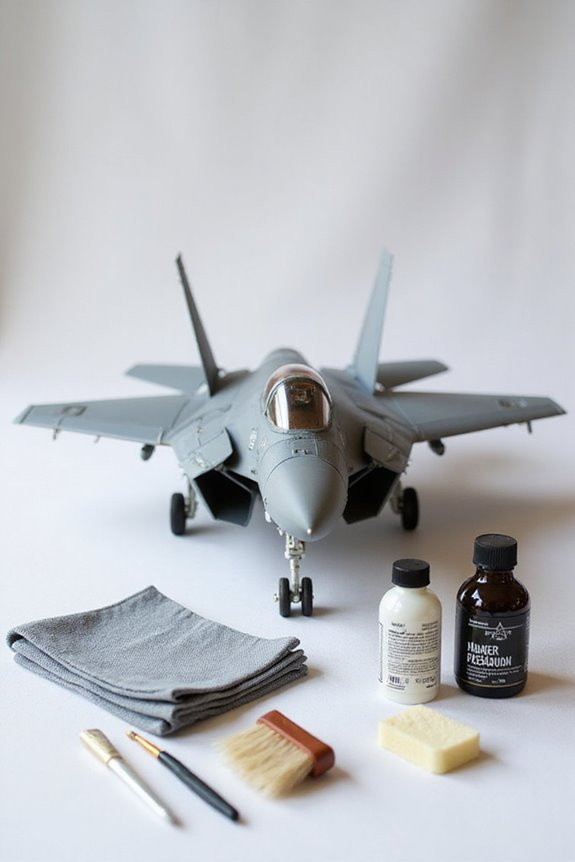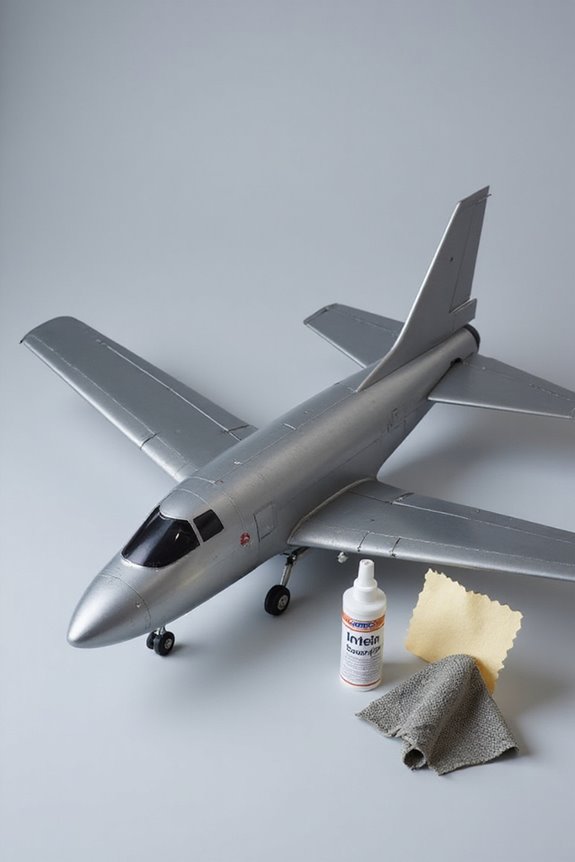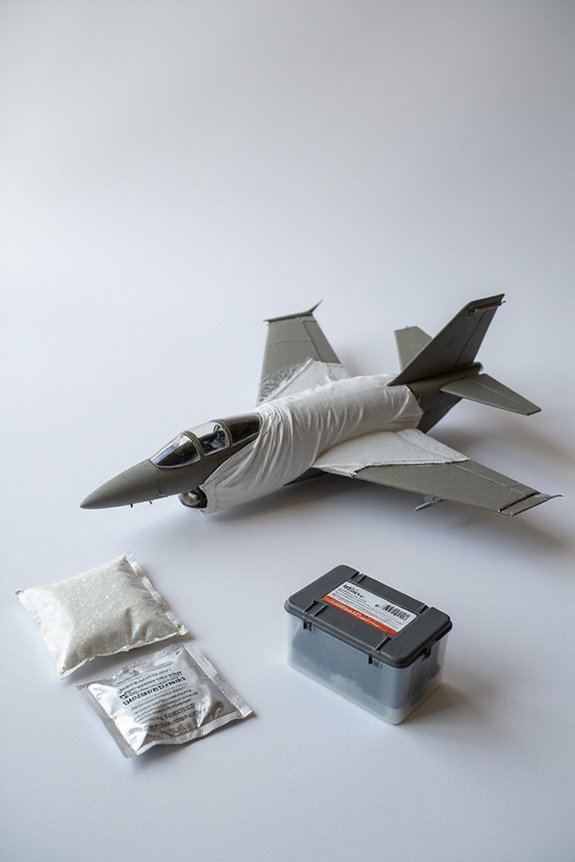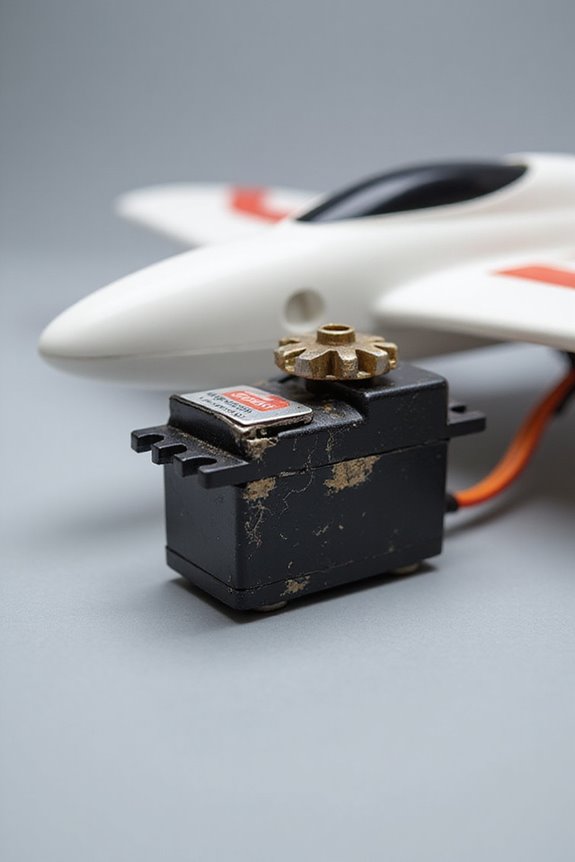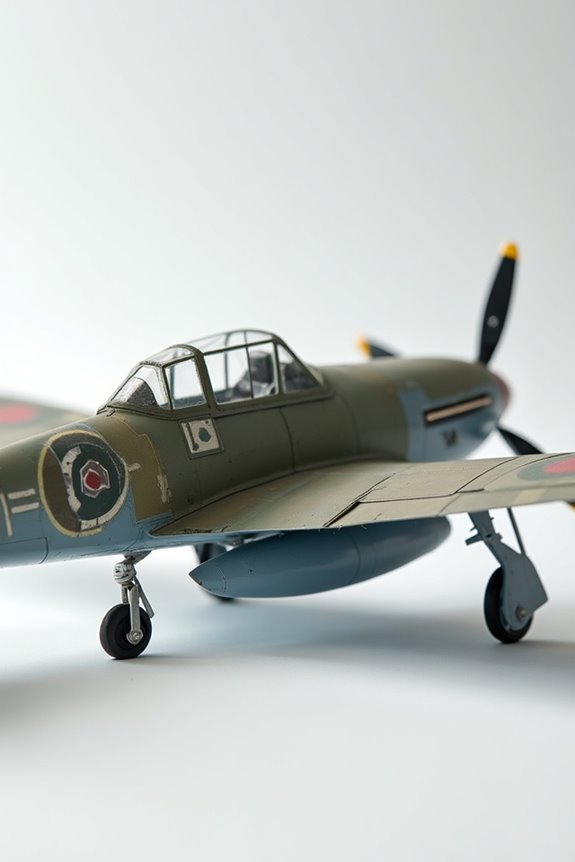To keep our model aircraft looking exceptional, we recommend a few stellar cleaning products. A mix of warm water and dish soap gently tackles dust and oils on plastic. For metal models, using mild soap in distilled water works wonders without risking rust. Got some greasy residue? Give Extreme Simple Green a try! It’s like magic for oily messes. Stick around, and you’ll discover more tools and tips for maintaining our beloved models!
Key Takeaways
- Dish soap and warm water effectively clean plastic parts, removing dust and oils without damaging the finish.
- Extreme Simple Green is ideal for removing oily residues from model aircraft with a safe spray-and-brush method.
- Use dedicated plastic cleaners like Polly Scale Plastic Prep to prepare surfaces for painting on plastic models.
- A mixture of distilled water and mild soap is safe for cleaning metal and diecast aircraft without causing harm.
- Always follow up cleaning with lint-free cloths for a spotless shine and to avoid any residue or streaks.
Essential Hand Tools for Cleaning Model Aircraft
When it comes to cleaning model aircraft, you might find yourself wondering what tools are truly essential. First up are soft brushes. We love using fine-bristled makeup brushes for dusting delicate surfaces. For those pesky hard-to-reach spots, horsehair or camelhair paint brushes in sizes #00 and #1 do wonders without scratching.
Cotton balls and swabs are our go-to for gently removing dust from grooves and panel lines. Microfiber pads buff the surface like a charm!
Let’s not forget precision tools! Fine-tip tweezers snag debris while toothpicks help with stubborn dirt. So, whether it’s brush types or clever cleaning techniques, having the right tools makes all the difference in keeping our model aircraft looking pristine!
Recommended Cleaning Solutions for Plastic and Paint
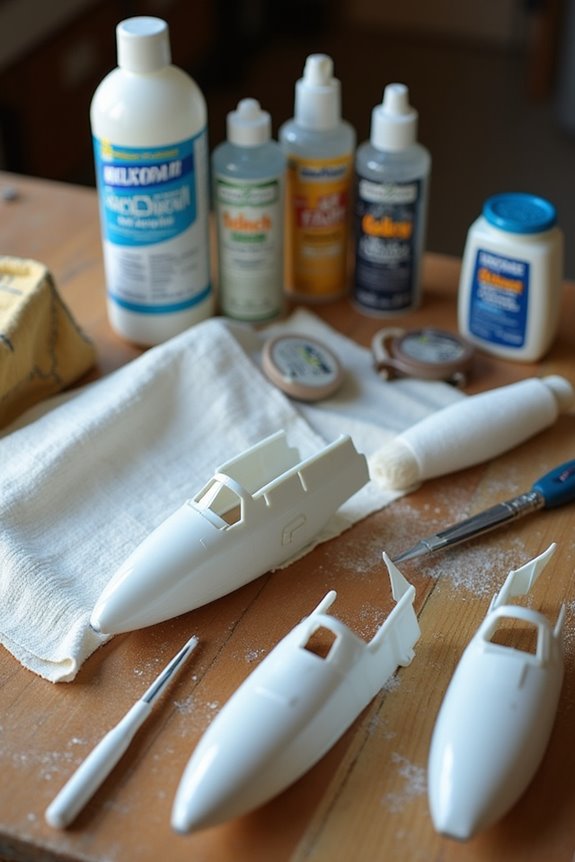
How can we keep our model aircraft looking as sharp as a freshly painted masterpiece? We recommend starting with good old dish soap and warm water. It effectively removes dust and oils from plastic parts without harming finishes. Soaking parts for about 10 minutes does wonders! Just don’t forget to rinse thoroughly to avoid soap residue—it’s like leaving icing on a cake when you want to paint it.
For an extra touch, dedicated plastic cleaners, like Polly Scale Plastic Prep, can help guarantee those surfaces are primed and ready for paint. Always check those cleaners on a small area first! Remember, avoiding abrasive materials is key—think gentle feather, not a lawnmower. Happy cleaning, friends!
Cleaning Metal and Diecast Model Aircraft
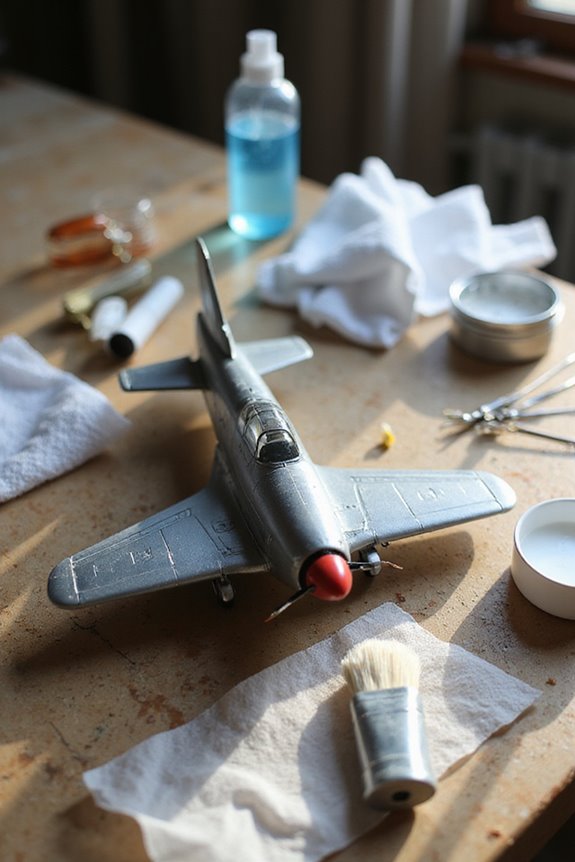
Cleaning metal and diecast model aircraft can feel a bit intimidating, but trust us, it’s all in the details. To keep our models shining, we should follow consistent maintenance routines. Using fine makeup brushes lets us dust delicate parts without making them cry. For tight spaces, precision tweezers are our best friends!
When cleaning, distilled water and mild soap diluted in lukewarm water work wonders. Regular light dusting prevents gunky build-up, while deep cleaning can involve a quick “car bath.” Just remember: no harsh chemicals! After cleaning, we carefully dry our models to avoid rust. By incorporating thoughtful cleaning techniques, we’ll guarantee our aircraft stay in mint condition and retain their value—just like that rare action figure from our childhood!
Effective Methods for Dealing With Oily Messes
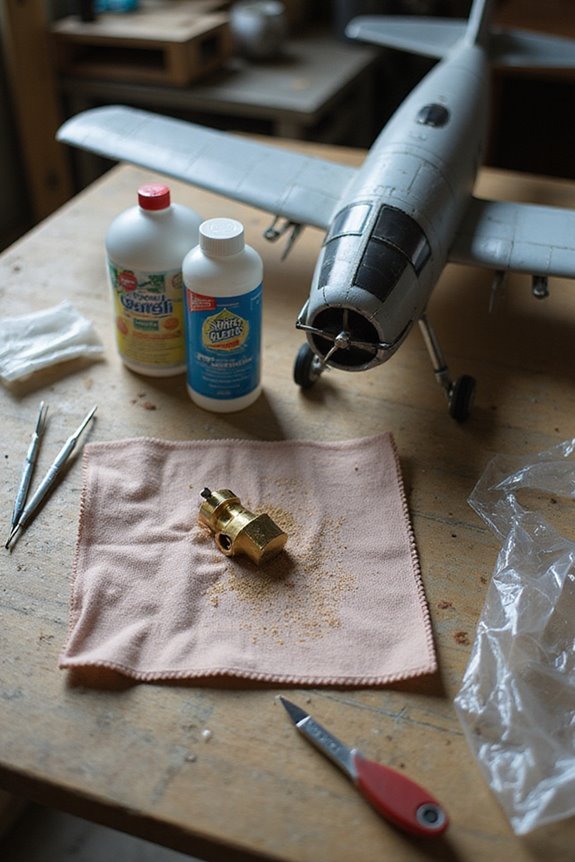
Dealing with oily messes on our model aircraft doesn’t have to feel like rocket science, even if those oil stains can be as stubborn as a kid refusing to eat their vegetables. For effective oily residue removal, we can rely on products like Extreme Simple Green. Just spray it on and brush it away! Goop hand cleaner is another easy option—just smear it on and wipe it off.
For tougher stains, mineral spirits are great, but let’s be careful to protect our delicate parts. Proper degreaser application is key; a soft brush helps to spread our cleaner and loosen grease. Don’t forget to finish up with lint-free cloths, moving smoothly for a spotless shine. Let’s keep our models looking sharp!
Specialty Products and Tools for Model Aircraft Maintenance
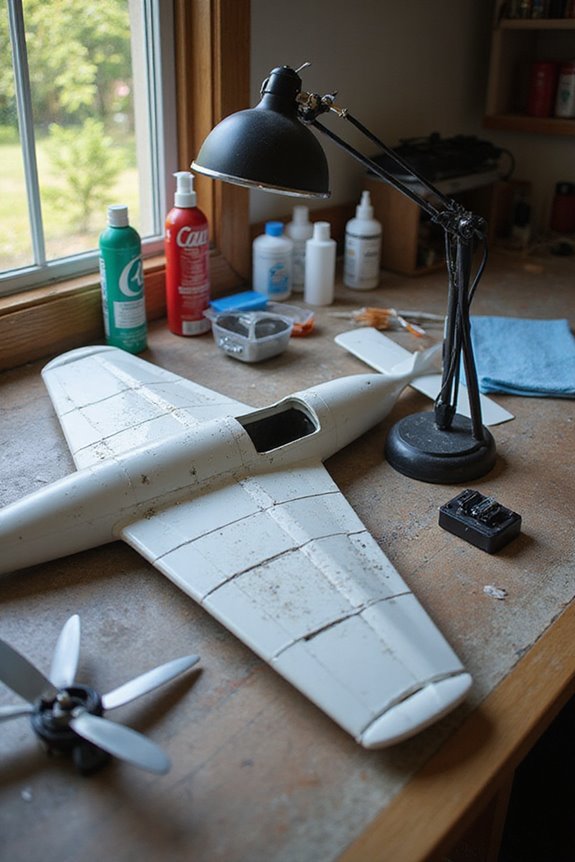
When it comes to maintaining our model aircraft, having the right tools and products can make all the difference. Specialty cleaners like biodegradable waxes keep our planes shiny without harming the environment. We can also use high-pressure cleaning machines for tough grime removal. They offer adjustable pressure, so we won’t accidentally dismantle our delicate models!
Don’t forget the essential cleaning accessories, like hydroentangled Sontara cloths that absorb like a sponge while leaving no lint behind. For those pesky upholstery stains, specialized removers are a must. Finally, thorough cleaning kits combine everything we need for a full maintenance session. After all, a happy model makes for happy flyers! So, let’s gear up and keep our aircraft pristine.
Preventative Maintenance for Long-Lasting Models
To guarantee our model aircraft soar through the skies for years to come, effective preventative maintenance is key. We need to keep tabs on our aircraft through regular preventative inspections. Checking for any cracks or loose fittings can save us from unexpected groundings.
Storing our models in a climate-controlled environment helps prevent warping and degradation. Think of it as a cozy home for our prized planes!
Documenting our findings in maintenance logs allows us to track any issues over time. By following the manufacturer’s maintenance schedule, we’ll catch problems before they become airborne disasters. Let’s protect our models with some love and attention, ensuring they stay in prime flying shape. After all, no one wants a “fly-by-wires” moment at 300 feet!
Tips for Safe and Effective Cleaning Techniques
Cleaning our model aircraft doesn’t have to feel like preparing for a NASA launch! To keep our models looking sharp, we should establish a regular cleaning frequency. Gently dust with natural fiber brushes; those fine bristles are perfect for avoiding scratches.
For tricky spots, let’s grab Q-tips or cotton balls, especially for intricate components like antennas. Using compressed air can also help dislodge stubborn dust without the risk of damage.
Don’t forget: dust prevention is essential! Storing our models in dust-free environments can save us cleaning headaches down the line. And remember, patience is vital! Taking our time prevents accidents and guarantees all parts stay intact. After all, we want our aircraft to soar, not flop!
Frequently Asked Questions
How Often Should I Clean My Model Aircraft?
Cleaning our model aircraft is like tending a garden; regular maintenance keeps everything thriving. We should clean based on usage conditions, following maintenance tips to determine frequency—weekly dusting and deeper cleaning monthly keep them in top shape.
Can I Use Baby Wipes for Cleaning My Models?
Yes, we can use baby wipes for light cleaning, appreciating their effectiveness. However, we need to evaluate model material compatibility, as moisture might affect sensitive areas like decals or finishes. Caution is always key!
Is It Safe to Use Water on My Model Aircraft?
When we consider water safety in cleaning techniques for our model aircraft, we must always use mild soap and warm water, avoiding excess moisture while ensuring thorough drying to keep our models pristine and safe.
What Should I Do if Paint Starts to Chip While Cleaning?
If paint starts to chip while cleaning, we should stop immediately. Then, we’ll assess the damage and proceed with chip repair and paint touch-up to guarantee a smooth restoration without causing further issues.
How Can I Prevent Static Electricity When Cleaning?
When we tackle cleaning, let’s aim to keep static discharge at bay. By employing effective cleaning techniques and ensuring proper grounding, we can create a safer environment for our models while enhancing their performance.

